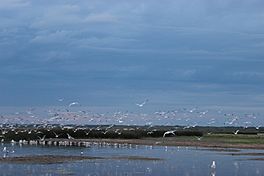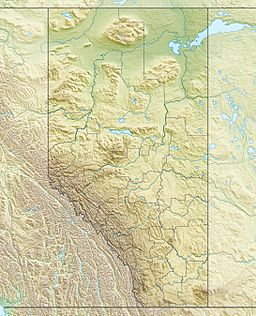Gull Lake (Alberta) facts for kids
Quick facts for kids Gull Lake |
|
|---|---|

Gulls of Gull Lake, Alberta
|
|
| Location | Lacombe County / Ponoka County, Alberta |
| Coordinates | 52°32′30″N 114°00′27″W / 52.54167°N 114.00750°W |
| Primary outflows | Blindman River |
| Catchment area | 206 km2 (80 sq mi) |
| Basin countries | Canada |
| Surface area | 80.6 km2 (31.1 sq mi) |
| Average depth | 5.4 m (18 ft) |
| Max. depth | 8 m (26 ft) |
| Residence time | >100 years |
| Surface elevation | 899 m (2,949 ft) |
| Settlements | Gull Lake |
Gull Lake is a big lake in central Alberta, Canada. It's a super popular spot for fun and relaxation. The southern parts of the lake have awesome sandy beaches.
Gull Lake is easy to get to, located right between the big cities of Edmonton and Calgary. It sits across two different areas, Ponoka County and Lacombe County. You can reach the north side of the lake by taking Highway 53 west from Ponoka. To get to the sunny southern beaches, drive west from Lacombe on Highway 12.
Contents
About Gull Lake's Size and Water
Gull Lake is quite large, covering about 80.6 square kilometres (31.1 sq mi). It's not super deep, with its deepest point being about 8 metres (26 ft). The area that drains water into the lake (called its catchment area) is 206 square kilometres (80 sq mi).
Several small streams, like Birch Bay Creek and Wilson Creek, flow into Gull Lake. The water from Gull Lake then flows out through a creek into the Blindman River. From there, it eventually reaches the Red Deer River.
Fun Times at Gull Lake
The small community of Gull Lake is located on the southern shore. It's right next to Aspen Beach Provincial Park. Many places to stay, like campgrounds and resorts, are found around the lake. These include Aspen Beach Brewers, Lakeview Provincial Park, Raymond Shores, and Degraffs Resort.
Gull Lake is known for its clear water and sandy beaches. This makes it a favorite place for many people, especially on warm, sunny weekends. Another popular lake, Sylvan Lake, is only about 20 km (12 mi) south of Gull Lake.
Early Settlers and Steamboats
The first people to settle around Gull Lake arrived around 1895. Many of them came from the United States. By 1902, most of the land was settled. A lumber industry also started up, using trees from the area.
In 1898, a 26 metres (85 ft) long steamboat was built. It was used to help with sawmill work at Birch Bay. This steamboat, and others like it, also carried passengers around the lake. By 1904, the area was already known as a fun summer resort.
Keeping Gull Lake's Water Level High
For many years, the water level in Gull Lake slowly dropped. This worried people who loved using the lake for fun. In 1967, studies began to figure out how to fix this.
In 1977, a special project started. Water from the Blindman River was pumped into Gull Lake through a pipeline and canal. This helps keep the lake's water level stable. Today, pumping happens when the lake level gets too low.
Aspen Beach Provincial Park
Aspen Beach Provincial Park was created in 1932. It was one of the very first parks in Alberta! This beautiful park is on the southwest shore of Gull Lake. It covers about 2.15 square kilometres (0.83 sq mi).
The park has two campgrounds with lots of spots for tents and RVs. There are also areas for group camping, a boat launch, and lovely beaches. You'll find modern washrooms and showers too. Many other campgrounds are also located around the lake.
At Gull Lake, you can enjoy many activities. These include sailing, power boating, swimming, fishing, and windsurfing. In some parts of the lake, power boats have a speed limit of 12 km/h (7.5 mph). Some areas might even be boat-free zones.
Fishing in Gull Lake
Gull Lake is a good spot for sport fishing. People mostly try to catch Northern pike and walleye. You can also find lake whitefish and burbot in the lake. Walleye have been added to the lake in recent years to help their numbers grow.
You can't fish in the canal that brings water into the lake. For the rest of the lake, the usual provincial fishing rules apply. In the winter, many people also enjoy ice fishing on Gull Lake!


